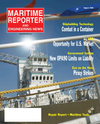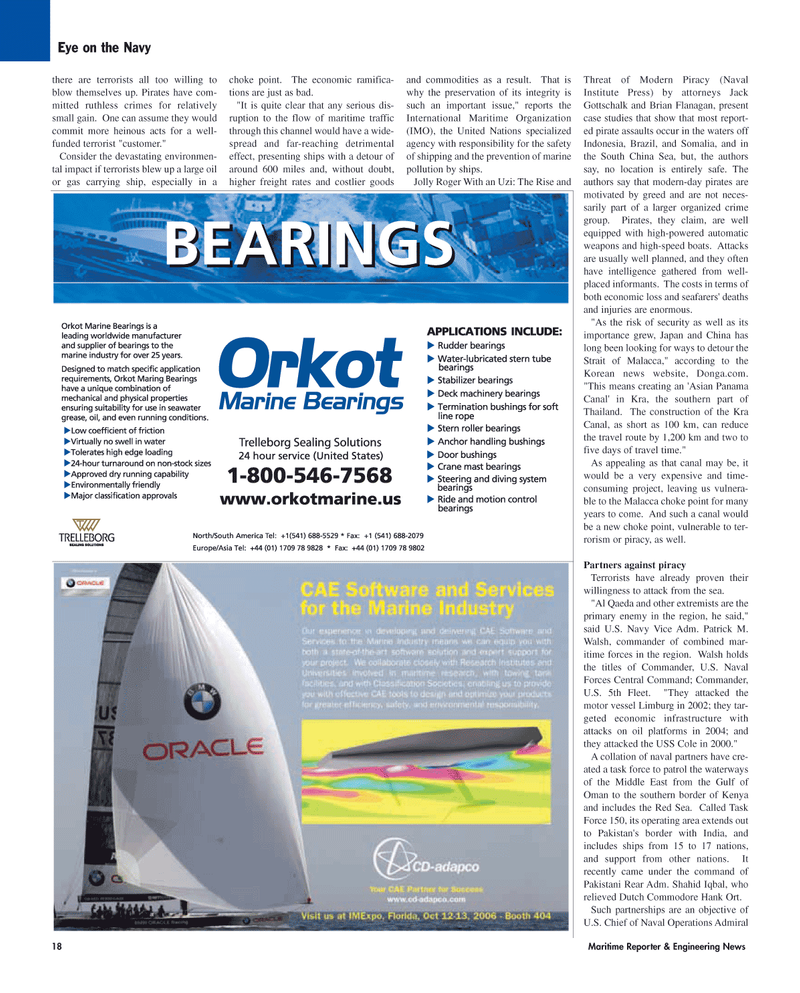
Page 18: of Maritime Reporter Magazine (August 2006)
AWO Edition: Inland & Offshore Waterways
Read this page in Pdf, Flash or Html5 edition of August 2006 Maritime Reporter Magazine
18 Maritime Reporter & Engineering News there are terrorists all too willing to blow themselves up. Pirates have com- mitted ruthless crimes for relatively small gain. One can assume they would commit more heinous acts for a well- funded terrorist "customer."
Consider the devastating environmen- tal impact if terrorists blew up a large oil or gas carrying ship, especially in a choke point. The economic ramifica- tions are just as bad. "It is quite clear that any serious dis- ruption to the flow of maritime traffic through this channel would have a wide- spread and far-reaching detrimental effect, presenting ships with a detour of around 600 miles and, without doubt, higher freight rates and costlier goods and commodities as a result. That is why the preservation of its integrity is such an important issue," reports the
International Maritime Organization (IMO), the United Nations specialized agency with responsibility for the safety of shipping and the prevention of marine pollution by ships.
Jolly Roger With an Uzi: The Rise and
Threat of Modern Piracy (Naval
Institute Press) by attorneys Jack
Gottschalk and Brian Flanagan, present case studies that show that most report- ed pirate assaults occur in the waters off
Indonesia, Brazil, and Somalia, and in the South China Sea, but, the authors say, no location is entirely safe. The authors say that modern-day pirates are motivated by greed and are not neces- sarily part of a larger organized crime group. Pirates, they claim, are well equipped with high-powered automatic weapons and high-speed boats. Attacks are usually well planned, and they often have intelligence gathered from well- placed informants. The costs in terms of both economic loss and seafarers' deaths and injuries are enormous. "As the risk of security as well as its importance grew, Japan and China has long been looking for ways to detour the
Strait of Malacca," according to the
Korean news website, Donga.com. "This means creating an 'Asian Panama
Canal' in Kra, the southern part of
Thailand. The construction of the Kra
Canal, as short as 100 km, can reduce the travel route by 1,200 km and two to five days of travel time."
As appealing as that canal may be, it would be a very expensive and time- consuming project, leaving us vulnera- ble to the Malacca choke point for many years to come. And such a canal would be a new choke point, vulnerable to ter- rorism or piracy, as well.
Partners against piracy
Terrorists have already proven their willingness to attack from the sea. "Al Qaeda and other extremists are the primary enemy in the region, he said," said U.S. Navy Vice Adm. Patrick M.
Walsh, commander of combined mar- itime forces in the region. Walsh holds the titles of Commander, U.S. Naval
Forces Central Command; Commander,
U.S. 5th Fleet. "They attacked the motor vessel Limburg in 2002; they tar- geted economic infrastructure with attacks on oil platforms in 2004; and they attacked the USS Cole in 2000."
A collation of naval partners have cre- ated a task force to patrol the waterways of the Middle East from the Gulf of
Oman to the southern border of Kenya and includes the Red Sea. Called Task
Force 150, its operating area extends out to Pakistan's border with India, and includes ships from 15 to 17 nations, and support from other nations. It recently came under the command of
Pakistani Rear Adm. Shahid Iqbal, who relieved Dutch Commodore Hank Ort.
Such partnerships are an objective of
U.S. Chief of Naval Operations Admiral
Eye on the Navy
MR AUGUST2006 #3 (17-24).qxd 8/2/2006 5:24 PM Page 18

 17
17

 19
19
